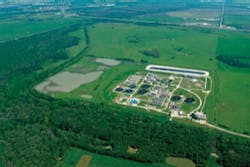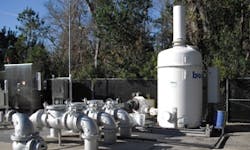Helping Haiti: 10 months on
A devastating earthquake earlier in the year shook the Caribbean island of Haiti and left over three million people without access to safe drinking water. Months later and reports suggest widespread outbreaks of cholera are plaguing the nation. Lis Stedman reviews progress to date of rebuilding destroyed water and sanitation infrastructure.
At 4.53pm on 12 January 2010, a devastating 7.0 magnitude earthquake with an epicentre ten miles west of Haiti's capital, Port-au-Prince, stripped away water and sanitation infrastructure that the world's NGOs and water experts already knew to be fragile and inadequate.
Before the earthquake, sanitation coverage nationally was just 17% - this being defined as at least access to a latrine of an acceptable quality. In the rural area this figure dipped to 10%, and sewers and wastewater treatment were unheard-of. The water supply figures were higher but still poor – 71% of urban areas and 51% of rural zones had some kind of improved water source.
In pure numbers, 3.7 million people nationwide - one in three – had no access to safe water. The patchy water service that existed was intermittent and poor, with rural area services mainly in a state of extreme disrepair. Indeed, after decades under control by a brutal government followed by a lack of focus on the sector, Haiti had the unenviable distinction of having the weakest water and sanitation infrastructure in the hemisphere.
The island, because of this, had a longstanding tradition of buying water by the gallon or 20 gallon bottle, and a large private sector services that trade – every neighbourhood had outlets where people collect water for drinking and cooking. Bulk water was trucked in by tanker or obtained from standpipes outside the areas served by the meagre piped water system.
Given this already dire situation, in some ways the earthquake could not have hit a more vulnerable place. In other ways, of course, the already extreme situation had its benefits – there were a number of NGOs already working in the area on the water and sanitation side.
Following the earthquake UNICEF took the lead and coordinated the WASH (water, sanitation and health) Cluster. This acts as a central strategic command where the various agencies can discuss their individual efforts to ensure that the maximum coverage and maximum benefit is obtained. There are a number of Clusters working in Haiti, focusing on the various key aid needs.
There have been strenuous concerted efforts to help – some tightly focused, such as Oxfam's evaluation of single-use 'Peepoo' bags in the Delmas area of Port-au-Prince. The odour-neutralising bags, which contain a chemical to break down human waste for use as a fertiliser, are used in conjunction with gender-segregated stalls, hand washing stations and regularly-emptied bins.
Bags are seen as a valid option because at some sites where refugees are living in the city, pit latrines simply are not feasible. Concrete or tarmac surfaces, a high water table or landowners prohibiting latrine digging are among the obstacles faced. Raised latrines are an option but desludging is expensive and truck access to many of the sites is difficult.
The list of organisations providing general water and sanitation aid after the earthquake is long, and includes French water giant Veolia, the Red Cross/Red Crescent, RedR. Tearfund, SOIL (which is piloting composting toilets and other ecosan techniques), MSB (the Swedish civil contingency agency), and many others. UNICEF has been pivotal to ensuring these many efforts mesh and work to best effect.
Marc Henderson, who is head of UNICEF's Water and Sanitation programme in Haiti, explains that the organisation's activities are divided between supporting the Haitian government and DINEPA, the National Directorate for Water Supply and Sanitation, and the WASH Cluster coordination role.
Henderson says that in the early days of the rapid response, three experienced coordinators from the organisation were brought in to work with the government on the initial actions. This included starting the massive water trucking operation and providing coordination for the various NGOs and UN agencies.
These three were joined by other experts with specialities in sanitation, hygiene and water supply, and over the course of the following months 25 international technical specialists arrived to provide coordination, technical assistance and support to DINEPA and other players.
"There are currently around 50 organisations providing assistance in the camps, not just in Port-au-Prince but in other towns and areas," notes Henderson.
The WASH Cluster has a target population of around 1.2 million, he adds. "Planning about the level of water and sanitation facilities that need to be provided is based on that estimate."
Most of this population are living in camps of all sizes, in temporary shelters or just tarpaulins or plastic sheeting.
"It has been critical to make sure they had toilets and water," Henderson explains. "Later came showers and drainage. Hygiene promotion is critical. UNICEF has trained hygiene staff and these staff have gone on and trained 4000 local hygiene promoters working in the camps and schools to promote proper hygiene and maintenance and cleanliness of the toilets."
The early key strategy of water trucking is now evolving to focus on what repairs can be made to the existing piped water network in neighbourhoods where there is no or insufficient water supply. In this effort UNICEF is working with CAMEP (Centrale Autonome Métropolitaine d'Eau Potable), the municipal utility responsible for the Port-au-Prince metropolitan area, and other large organisations that are interested in undertaking repairs and connecting the camps to piped water systems. "It will ease the need for trucking but it is a longer term effort," says Henderson. "It is not easy to know where the damage is or which pump stations to repair for the most benefit."
The Inter-American Development Bank (IDB), one of the key lending banks to the area, is to invest in the Port-au-Prince system under a privatized contract - a longer-term project that may not start up for a year or two. This will involve not just rehabilitation of the shattered infrastructure but management of the water utility, CAMEP, Henderson explains.
UNICEF is formulating plans for the next two years. "There will still be a requirement for facilities in camps but we are looking at developing a longer-term plan with the government and NGOs with more of a development focus, even moving outside the earthquake-affected area into the rural zone where UNICEF was working before the disaster to improve water and sanitation which was pretty bad – certainly the worst in the region," adds Henderson.
Bracing the island for stormy season
There are immediate concerns that are equally difficult though, including the fact that the hurricane-prone island is now facing its stormy season. A small, sharp storm recently blew down many tents and tarpaulin shelters, flooding latrines and ripping some of their roofs off. Larger storms have the potential to wreak much havoc.
Aid has come in many different shapes and sizes, and some invaluable input has been provided at household level outside the capital.
Michael Ritter is the national program director for Deep Springs International, a non-profit organisation that provides a household level chlorination system for potable water. He was in Haiti before and during the earthquake, and is still working there now on the relief effort. He outlines the work being undertaken in Léogane and the surrounding area, which were hit badly by the earthquake.
"It was one of the most affected areas," he explains. "The earthquake was 7.5 here but with a much smaller population so there were less deaths but a lot of destruction. Over 80% of the buildings were destroyed."
He notes: "It was the scariest experience of my life. Fortunately where I was, was very remote. It has been a busy and crazy time since. We are working through a network of community health workers distributing training. We are providing chlorination which we produce in Léogane and distribute."
A network of 150 health agents distributed 100 systems following the quake, reaching 15,000 families and 100,000 individuals in total. But as Ritter explains: "We are dealing with a lot of the same challenges we had before the quake, just on a greater level." Many people use wells in the town, he says, and some companies with RO systems sell water to locals.
"Outside the town RO-treated [Reverse Osmosis] water is not an option because of distance and money," he adds. In the rural areas, wells and capped springs were the most common sources of water. Many of these, of course, have been destroyed by the earthquake.
"It is the rural areas where the household approach works best because of the lack of surface water sources. That's where we've been focusing, and the urban focus is on water trucking – this has been and still is the primary way of getting water to people."
Léogane is trying to phase trucking out, he says in favour of rehabilitating the existing network and extending the household approach.
Surveying the damage
Ritter says that efforts to determine the damage began soon after the earthquake. "There were efforts quickly after the quake to map the wells in the Leogane commune area and there certainly was an effect from it." However, there were a number of systems out of use before the quake for a number of reasons, he adds.
Other groups are working in the area on rehabilitating hand pumps he says, including Living Water International. "I would say that things have improved. Relative to other sectors the water response was fairly quick - with water trucking they were able to reach a lot of people fairly quickly. In some areas the situation is better than before the quake."
In the longer term it is recognised that water trucking is not sustainable and in terms of sanitation, there is still a long way to go before it can be said that Haiti has anything like an acceptable system. The sanitation response also lagged behind the water efforts, Ritter notes, but has caught up – there are a number of groups in the area are now working in this field, building latrines.
The hope is that the water and sanitation situation will improve to the extent where the Haitian government can take the lead, he adds: "We are heading in the right direction but it is very slow as with a lot of things in Haiti. There are not a lot of projects in place. I think we are talking a matter of years before we can say the government has got it under control and is leading in the right direction and taking positive steps. We are seeing improvements. What keeps us going is the hope that it will continue.'
NGOs, of course, are making a significant contribution to the water and sanitation efforts. Rainer Eckart of Malteser International (the humanitarian aid arm of the Sovereign Order of Malta, which descends directly from the Knights Hospitaller who provided medical aid to pilgrims during the Crusades), explains that he was sent by the organisation to Haiti in the aftermath of the earthquake.
"Malteser International was present just after the earthquake in the town of Léogane. The epicentre of the earthquake was very close but offshore and it was the town that was most hit," he says.
Although the organisation has had a medical focus since the days of the Crusades, Ritter explains: "There is also a need for WASH activities, to improve the water situation and with respect to hygiene and construction of latrines. It was my mission to identify projects in the Léogane area and also partner projects outside Léogane constructing latrines and supplying drinking water to the town of Petit Goave, 20km from Léogane."
The earthquake ran along a line stretching east-west from the centre of the island to the southern peninsula, he explains. "The damages even to WASH activities were high. In the situation before the earthquake the urban systems didn't work. The NGOs are trying to rebuild, but it will take time."
The hinterlands to the south of Léogane comprise hills and mountains with many rivers and springs, one of which had been channelled to take water to Léogane. However two years ago heavy flooding damaged this line, so the city was suffering water problems well before the earthquake.
Save the Children and various US-based NGOs are working in the town itself, he adds, and Japanese engineers are working to repair the damaged supply line to the city.
Eckart adds: "In Petit Goave part of the town disappeared during the earthquake – a small strip of coast disappeared into the sea and did major damage to the water system that supplied people close to the shore. We have a partner project running water treatment with a smaller German NGO supplying the equipment."
The water treatment unit treats turbid river water and then chlorinates it. The quality of the drinking water is tested onsite in a small laboratory. Towns along the earthquake line were the worst hit, he notes, with less damage in the rural hinterland. Most hand pumps are working, he adds, but most household latrines were destroyed.
Waterborne disease outbreaks
Deep Springs International's Ritter also has serious concerns about waterborne disease, particularly in the rural areas where people are using damaged surface water sources. "We have discussed this and propose to drill wells to provide better water and to provide new latrines to replace those that have been destroyed," he says.
He goes on to say: "The situation is not easy, there are so many things to do. It will take time. The first step was to provide shelter, and other steps followed."
Looking to the future and when water and sanitation will return to normality, he says: "I'm afraid it will take years particularly in the urban areas. If you travel across Port-au-Prince by car there are still a lot of damaged houses that have to be pulled down. They have to find the owners to do this and many have gone to the US to work there and send money back."
Getting back on track
More and more, organisations are finding work for local people cleaning out water channels and riverbeds, repairing pipes and so on, he adds. These include mainly women, working for around €4 per day. Such sad remnants of a shattered population are toiling slowly with pickaxes and shovels to return their homeland to something resembling a normal water and sanitation situation.
Life in general is returning to a sort of normality on the island, and clearly the efforts on water and sanitation are bearing fruit and evolving. There are plans to put people into transitional shelters – more planned camps with durable shelters, water and sanitation, but much is on hold because of a political vacuum ahead of the elections in November.
Much improvement is at some distance beyond that date. The IDB project, which will be the major factor in restoring or creating proper water and sanitation, will not be complete for four or five years. The tent cities will remain, partly because people want to stay near their shattered houses.
Author's note: Readers wishing to donate to the Haiti recovery operations can visit: www.malteser-international.org.
British Red Cross EffortsBritish Red Cross sanitation team manager Chris Brewer explains that the charity has focused its efforts on two of the refugee camps – a large one with around 40,000 people in and a smaller one that originally held 12,000. Brewer estimates that the camp dwellers are likely to have to remain for over two years: "Pit latrines fill up quickly. We need a more sustainable solution."
The rains, which began in late July, have exacerbated the situation, flooding the pit latrines and making their flaws obvious. "We've opted for raised tank latrines – a wooden structure where the latrine is raised up, on a wooden platform four or five feet high with a large water tank beneath it." This type of latrine cannot flood, and the waste is emptied by desludging lorries at regular intervals.
In the larger of the two camps, around 250 of these new latrines have now been installed – the Red Cross prefabricates these at a workshop facility next to its warehouse. 'It's almost an Ikea toilet unit," Brewer jokes. The prefabricated sections are then shipped to the camps and erected.
There are 40 of the new latrines in the second, smaller camp, which now has just 4000 residents – this is because the landowner simply evicted the remaining refugees.
In both camps the water supply is pretty good, he adds – in the larger camp, which is in a sports stadium and therefore had some existing infrastructure, there is a mains water supply that has just been augmented. Large corrugated steel water tanks from Oxfam have been installed, the main problem being getting the water from this point to each of the ten shower blocks. "People are having to use buckets to move the water," Brewer explains. "We are working to move the water out to the showers."
These have been located next to existing drainage canals so that the greywater from the showers discharges straight to the watercourse. This helps to prevent logistical and health issues – there is little gradient in the camp.
The main challenge at the moment, he says, is keeping the drainage channels clear because the heavy rains would otherwise flood further areas. The work has strong social aspects, he adds. "The programme involves a lot of diplomacy to the communities. These are people who have lost everything and the question is should the work be done voluntarily, or should it be on a payment basis? We are trying to offer jobs and training so that we can keep the neighbourhoods clean and healthy."
More Water & WasteWater International Current Issue Articles
More Water & WasteWater International Archives Issue Articles





